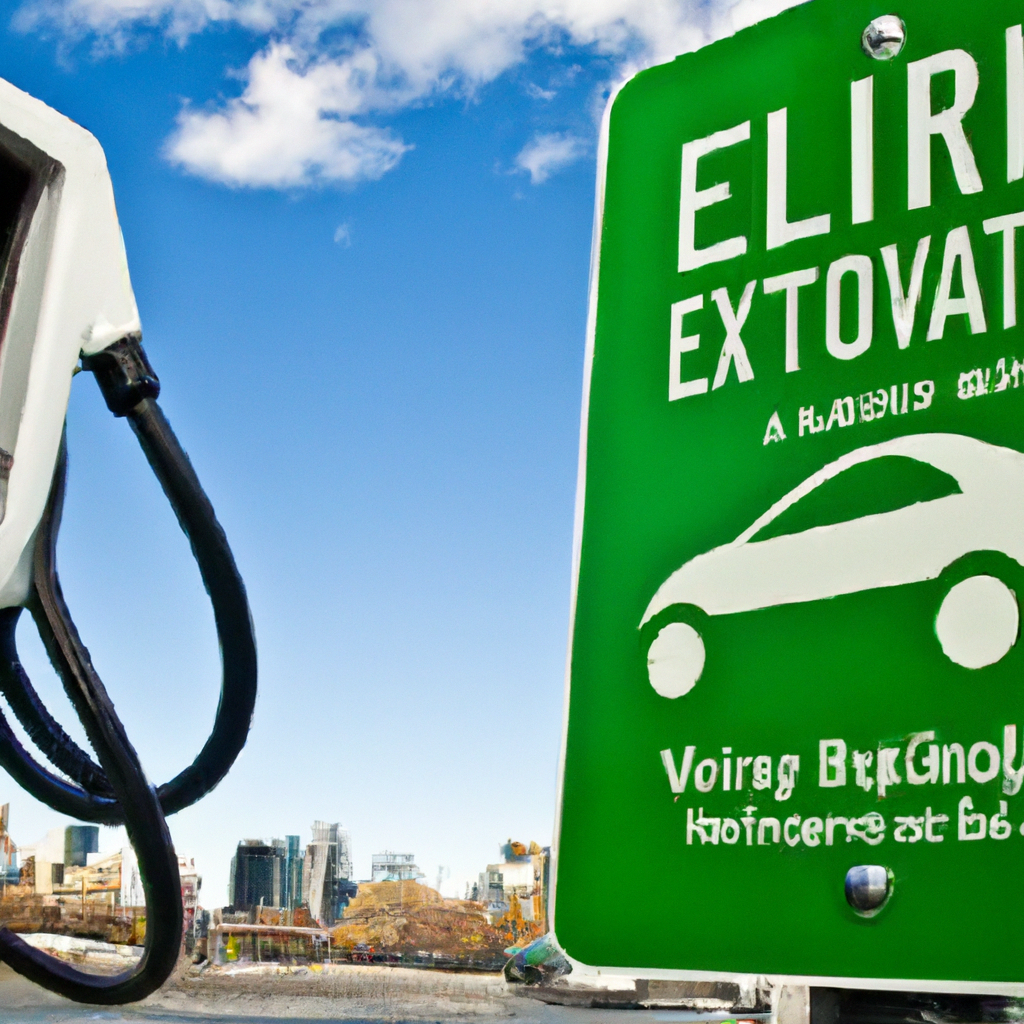The Role Of Government Incentives In Promoting EV Adoption
September 25, 2023 | by Jacob Kang

In today’s world where sustainability and reducing carbon emissions are at the forefront of discussions, electric vehicles (EVs) have emerged as a promising solution. However, the widespread adoption of EVs faces various challenges such as high prices and limited charging infrastructure. This is where government incentives play a crucial role in promoting EV adoption. By offering financial incentives, tax benefits, and subsidies, governments can encourage individuals and businesses to transition to electric vehicles, ultimately helping to create a greener and more sustainable future for all.
1. Types of Government Incentives
Government incentives play a crucial role in promoting the adoption of electric vehicles (EVs) by providing financial support and creating a favorable environment for consumers and businesses alike. There are three main types of government incentives: tax credits and rebates, grants and funding programs, and infrastructure investment.
1.1 Tax Credits and Rebates
Tax credits and rebates are one of the most common forms of government incentives for EV adoption. These incentives provide financial relief to individuals and businesses who purchase or lease electric vehicles. By offering tax credits, governments aim to reduce the upfront cost of EVs and promote their affordability.
1.2 Grants and Funding Programs
Grants and funding programs are designed to provide financial support to various stakeholders in the electric vehicle industry. These programs may offer grants to electric vehicle manufacturers for research and development, funding for charging infrastructure projects, or financial assistance for consumers who wish to purchase an EV.
1.3 Infrastructure Investment
Investment in charging infrastructure is critical for widespread EV adoption. Governments play a vital role in supporting the development of charging stations and expanding the grid capacity. By providing incentives to public and private entities, governments encourage the deployment of charging infrastructure in convenient locations, making EV charging more accessible for consumers.
2. Tax Credits and Rebates
2.1 How Tax Credits and Rebates Work
Tax credits and rebates are financial incentives provided by governments to individuals and businesses who purchase or lease electric vehicles. Tax credits work by reducing the amount of taxes owed by the taxpayer, while rebates provide a direct cash payment or a reduction in the purchase price of the EV.
2.2 Examples of Successful Tax Credit Programs
Several countries and regions have implemented successful tax credit programs to promote EV adoption. For instance, in the United States, the federal government offers a tax credit of up to $7,500 for the purchase of eligible EVs. In China, EV buyers can benefit from various subsidies and exemptions from purchase taxes. Norway has one of the most successful tax credit programs, allowing EVs to be exempt from various taxes and tolls, making them more cost-effective for consumers.

3. Grants and Funding Programs
3.1 Funding Programs for EV Manufacturers
To encourage innovation and research in the electric vehicle industry, governments often provide funding programs for EV manufacturers. These programs offer financial support for research and development activities, enabling manufacturers to improve the performance, efficiency, and affordability of electric vehicles.
3.2 Grants for Research and Development
Governments also offer grants to research institutions and universities to promote studies and advancements in electric vehicle technology. These grants support the development of new technologies, such as more efficient batteries and charging systems, which can further enhance the appeal of electric vehicles.
3.3 Support for Charging Infrastructure
The establishment of a comprehensive charging infrastructure network is crucial for the widespread adoption of electric vehicles. Governments provide grants and funding to support the installation of charging stations, both in urban areas and along highways. By investing in charging infrastructure, governments aim to alleviate range anxiety and increase consumer confidence in EVs.
4. Infrastructure Investment
4.1 Building Charging Stations
Investment in charging infrastructure is essential for the growth of the electric vehicle market. Governments, both national and local, play a vital role in building charging stations across the country. By strategically locating charging stations in residential areas, commercial spaces, and public spaces, governments ensure that EV owners have convenient access to charging facilities.
4.2 Expanding Grid Capacity
As the demand for electric vehicles increases, governments must invest in expanding the grid capacity to support the charging needs of EV owners. This involves upgrading and expanding existing power infrastructure to accommodate higher electricity consumption. By doing so, governments ensure that the grid can handle the increased load from a surge in EV adoption.
4.3 Incentives for Public and Private Entities
Governments incentivize public and private entities, such as businesses and property developers, to invest in charging infrastructure. This can be in the form of funding assistance, tax incentives, or streamlined permitting processes. By encouraging the establishment of charging stations at workplaces, shopping centers, and apartment complexes, governments enhance the convenience and accessibility of EV charging.

5. Benefits of Government Incentives for EV Adoption
5.1 Encouraging Technological Innovation
Government incentives for EV adoption drive technological innovation in the electric vehicle industry. By providing funding for research and development, governments support the advancement of electric vehicle technology, such as battery technology, charging infrastructure, and renewable energy integration. These innovations enhance the performance, efficiency, and affordability of electric vehicles, making them more attractive to consumers.
5.2 Creating Job Opportunities
Government incentives for EV adoption also stimulate job creation in various sectors, including manufacturing, research and development, and charging infrastructure installation. As the demand for electric vehicles grows, the industry requires an expanded workforce to design, produce, and maintain electric vehicles and their associated infrastructure. This job growth contributes to the overall economic development of the country.
5.3 Reducing Air Pollution and Greenhouse Gas Emissions
One of the most significant benefits of government incentives for EV adoption is the reduction of air pollution and greenhouse gas emissions. Electric vehicles produce zero tailpipe emissions, unlike conventional gasoline-powered vehicles. By encouraging the transition to electric vehicles, governments can significantly contribute to reducing air pollution and combating climate change. EVs also have the potential to integrate with renewable energy sources, further reducing carbon emissions and dependence on fossil fuels.
6. Challenges and Criticisms
6.1 Cost and Effectiveness
Critics argue that government incentives for EV adoption can be costly and may not always be effective in achieving their intended goals. Some question whether the incentives are worth the investment, especially if they primarily benefit wealthier individuals who can afford electric vehicles without financial assistance. Additionally, measuring the effectiveness of incentives in driving widespread adoption can be challenging, as multiple factors contribute to EV market growth.
6.2 Equity and Accessibility
Another concern is the equity and accessibility of government incentives. It is essential to ensure that incentives are accessible to all segments of society, including low-income communities. Governments must consider implementing programs that provide financial support to individuals with limited financial resources to make electric vehicles more accessible and equitable.
6.3 Potential for Market Distortion
Government incentives for EV adoption can also create market distortions, especially if the incentives favor specific manufacturers or technologies. Critics argue that governments should focus on providing a level playing field for all players in the electric vehicle industry to encourage fair competition and technological innovation.

7. International Examples of Government Incentives
7.1 Norway’s Success Story
Norway has achieved remarkable success in promoting EV adoption through government incentives. The country offers generous tax exemptions, toll discounts, and free parking for electric vehicles. These incentives, combined with a comprehensive charging infrastructure network, have led to Norway having one of the highest EV adoption rates globally.
7.2 China’s Aggressive EV Incentives
China has implemented aggressive EV incentives to tackle air pollution and reduce dependence on imported oil. The Chinese government offers substantial purchase subsidies, tax exemptions, and free license plates for electric vehicles. These incentives, along with stringent emission standards and the establishment of charging infrastructure, have made China the world’s largest electric vehicle market.
7.3 Germany’s Transformation towards Electric Mobility
Germany, known for its strong automotive industry, has also embraced government incentives for EV adoption. The country provides generous purchase incentives for electric vehicles, as well as subsidies for charging infrastructure installation. Germany aims to become a leader in electric mobility and has set ambitious targets to increase the number of electric vehicles on its roads.
8. Future Outlook for Government Incentives
8.1 Increasing Support for EV Adoption
The future looks promising for government incentives in promoting electric vehicle adoption. Many countries are recognizing the importance of transitioning to cleaner transportation and reducing greenhouse gas emissions. Governments are likely to continue increasing support and funding for electric vehicle research, development, and adoption to accelerate the transition to a sustainable transportation system.
8.2 Shifting Focus to Renewable Energy
As the world moves towards decarbonization, governments are increasingly focusing on promoting the integration of renewable energy sources with electric vehicle charging infrastructure. By incentivizing the use of renewable energy for charging EVs, governments can further reduce carbon emissions and promote a cleaner energy mix.
8.3 Balancing Regional and National Needs
Different regions and countries have varying needs and conditions when it comes to electric vehicle adoption. Governments must strike a balance between national and regional incentives to ensure that all areas have equal access to support and funding. This approach can maximize the impact of government incentives and encourage widespread EV adoption across the entire country.

9. Conclusion
Government incentives play a crucial role in promoting electric vehicle adoption by reducing the upfront cost, supporting technological innovation, creating job opportunities, and addressing environmental challenges. Through tax credits and rebates, grants and funding programs, and infrastructure investment, governments provide the necessary financial support and create a favorable environment for the growth of the electric vehicle industry. While challenges and criticisms exist, the benefits of government incentives outweigh the drawbacks, resulting in increased EV adoption and a more sustainable transportation future. As countries worldwide continue to invest in and refine their government incentive programs, the future for electric vehicles looks promising, with increased support and a focus on renewable energy integration.